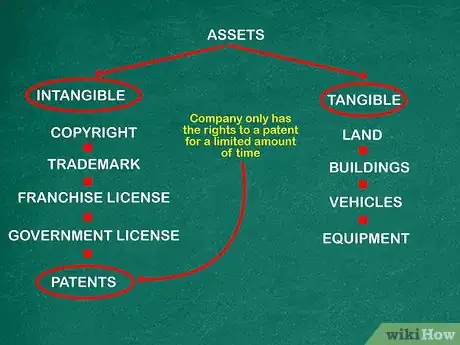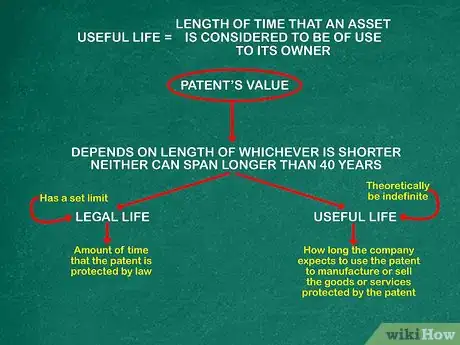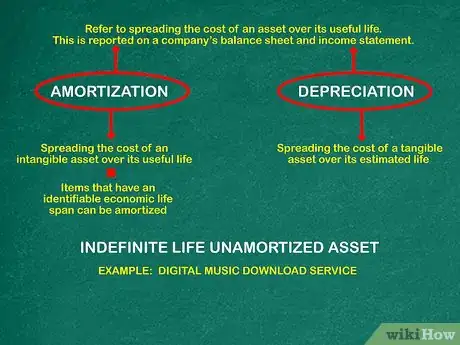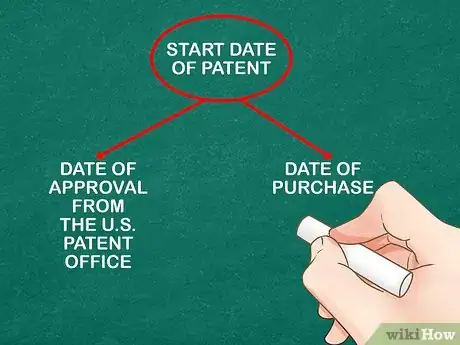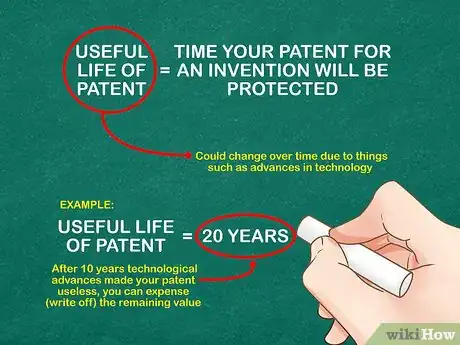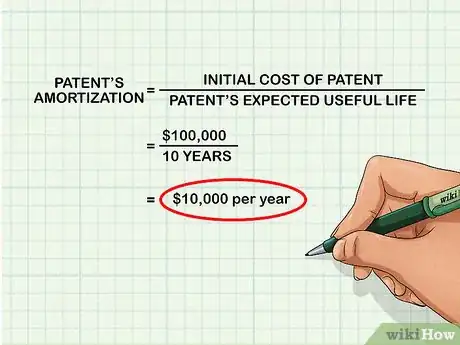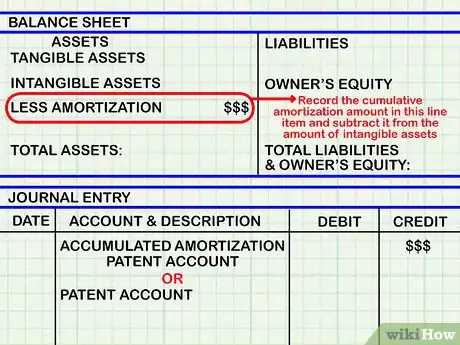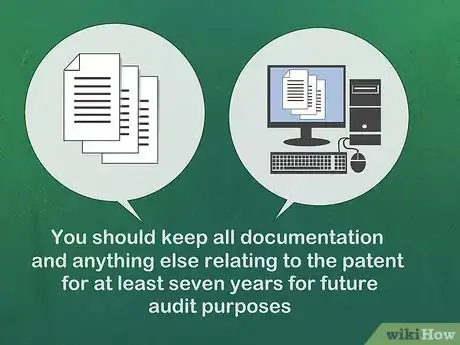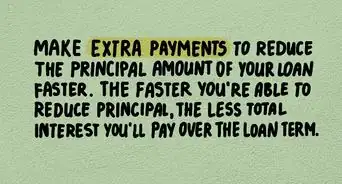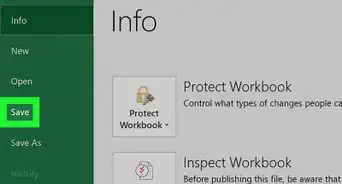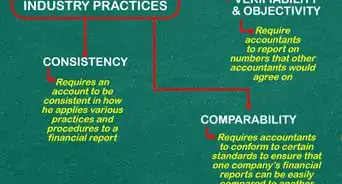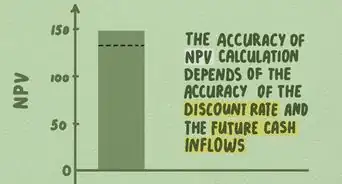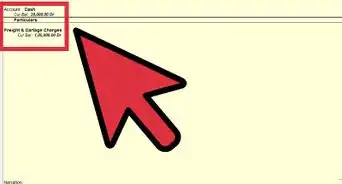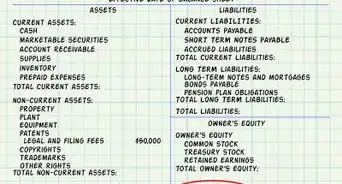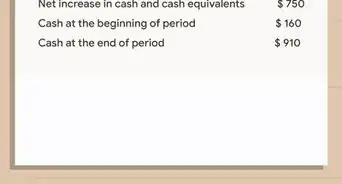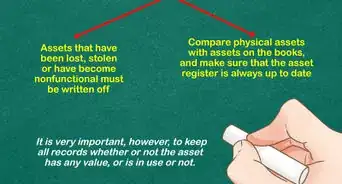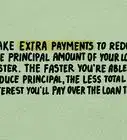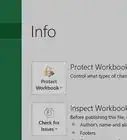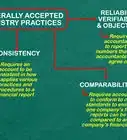X
wikiHow is a “wiki,” similar to Wikipedia, which means that many of our articles are co-written by multiple authors. To create this article, 9 people, some anonymous, worked to edit and improve it over time.
This article has been viewed 129,223 times.
Learn more...
Patents allow inventors the exclusive rights to produce and sell their new inventions, as long as it is new, not obvious, and useful. The method in which businesses allocate the cost of these intangible assets over a period of time is considered the amortization of assets. The formula to calculate a patent's amortization is similar to the straight-line depreciation calculations for other intangible assets.
Steps
Part 1
Part 1 of 3:
Understanding Patents as an Intangible Asset
-
1Define patents as a type of intangible asset. Similar to a copyright, trademark, trade name, franchise license, government license, etc., patents are considered to be "intangible." A company only has the rights to a patent for a limited amount of time.[1]
- Examples of tangible assets are land, buildings, vehicles and equipment.
-
2Define useful life. This is the length of time that an asset is considered to be of use to its owner. For example, when a pharmaceutical company receives a patent on a new drug, it is only for a specific period of time, such as 20 years. After that time other pharmaceutical companies can produce the same type of drug. Therefore its useful life is 20 years. If you needed to estimate the useful life of a trademark such as kleenex, for example, you could look up information on the Internet for estimates of useful lives of similar trademarks.
- The patent's value is dependent on the length of either its useful life or its legal life, whichever is shorter, but neither can span longer than 40 years.
- The patent's legal life is the amount of time that the patent is protected by law, while its useful life is how long the company expects to use the patent to manufacture or sell the goods or services protected by the patent.
- The useful life might theoretically be indefinite, while the legal life of the patent has a set limit. On the other hand, the company may find that their expected useful life is shorter than the legal life, especially in a rapidly evolving industry. In either case, the shorter of the two lives is used.[2]
Advertisement -
3Define amortization vs. depreciation. Both amortization and depreciation refer to spreading the cost of an asset over its useful life. This yearly amount is reported on a company's balance sheet and income statement. Amortization refers to spreading the cost of an intangible asset over its useful life. Depreciation refers to spreading the cost of a tangible asset over its estimated life. Since patents are intangible, they are amortized.[3]
- Only items that have an identifiable economic life span can be amortized. Other intangible assets that have an indefinite life span are not amortized, but instead are evaluated for relevancy or destruction from time to time. If these assets never show a decrease in relevance or destruction of any sort, the indefinite life assets will remain on your balance sheet permanently. An example of an indefinite life, unamortized asset would be a digital music download service. As long as the service is free from destruction and continues to be economically relevant, it remains on a balance sheet.
Advertisement
Part 2
Part 2 of 3:
Calculating Amortization on Patents
-
1Determine the initial cost of the patent itself. A patent's initial cost is based on the invention in which the patent belongs to and its comparison to prior inventions of similar nature. For this example, the initial cost of the patent will be $100,000.
- You could also add up all the research and development costs incurred to design the invention.
- R&D costs are expensed until future economic benefits are probable, then future costs (called engineering and development costs) are capitalized (added to the intangible asset - patent account) and amortized.
- Patent costs go far beyond the initial cost of development. Some of the regulatory costs include patent application cost, prosecution costs to verify is originality, and an issuing fee. Maintenance fees also are charged every 3.5, 7.5, and 11.5 years to continue the patent's validity. There is also a filing fee which is dependent on the number of claims associated with the invention's particular application, which typically ranges from $400 to $1000 or more. The highest charges for most patent applicants are the charges made by the patent attorney or agent that prepares the actual patent application.[4]
-
2Determine the start date of the patent. Amortization of patents begins when it is acquired or when it is available for use. For example, this would be the date a patent was purchased or when approval was received from the U.S. Patent Office.[5]
-
3Obtain the length of the patent's estimated useful life. You will need to find out the duration of the patent. For example, imagine that your patent for an invention will be protected for 10 years, as stated when the patent was first granted. This will be the useful life of your patent.
- However, the useful life of a patent could change over time due to things such as advances in technology. For example, if you assumed the patent was useful for 20 years, but after 10 years technological advances made your patent useless, you can expense (write off) the remaining value.
-
4Calculate the patent's amortization. Divide the value of the initial cost of the patent by the patent's expected useful life. The result is the amortization of the patent. For this example, the initial cost is $100,000 and the useful life span is 10 years; therefore, the patent's amortization is $100,000 / 10 years = the patent's amortization amount of $10,000 per year.
Advertisement
Part 3
Part 3 of 3:
Recording Amortization on Financial Statements
-
1Record the amount of amortization on the company's balance sheet. A line item will exist on the balance sheet for intangible assets. A line under this will say "Less Amortization." Record the cumulative amortization amount in this line item and subtract it from the amount of intangible assets.
- To record, make an entry crediting the accumulated amortization-patent account for the amount of the amortization.
- Alternately, many companies simply choose to credit the patent account directly for the amount of the amortization.
-
2Record the amount that is amortized per year on the company's income statement. This is called "amortization expense" and is considered a cost of doing business that is subtracted from revenue. It is usually included under the "depreciation and amortization" line item.[6]
- An equivalent debit to the credit made in the last step should be made to the amortization expense account (in both cases).
-
3Keep good records. You should keep documentation of all invoices, patent grants, costs of research and development, and anything else relating to the value or useful life of the patent for at least seven years for future audit purposes. Note the dates that all patents were acquired and the cost for each.
Advertisement
Community Q&A
-
QuestionWhat if there is more legal fees incurred before end of patent life?
 Community AnswerLegal fees incurred after you have calculated your patent cost and started an amortization schedule can be capitalized. This means that they are added to the patent account and amortized over time in the same way.
Community AnswerLegal fees incurred after you have calculated your patent cost and started an amortization schedule can be capitalized. This means that they are added to the patent account and amortized over time in the same way. -
QuestionCan I start to amortize patent costs during the application process perhaps for a 36 month period while I wait to see if the patent is approved?
 Community AnswerYou cannot amortize a patent that you do not yet hold. However, once you get the patent, you can amortize the expenses you are currently paying to get it approved.
Community AnswerYou cannot amortize a patent that you do not yet hold. However, once you get the patent, you can amortize the expenses you are currently paying to get it approved. -
QuestionWhat is a patent originally has a legal life of 10 years, but after 2 years it's determined it only had a legal life of 6 years?
 Community AnswerIf the legal life runs out before your patent is fully amortized, you can record a derecognition of the patent by debiting the accumulated amortization account and crediting the patent account. The unamortized balance must then be recorded as a loss.
Community AnswerIf the legal life runs out before your patent is fully amortized, you can record a derecognition of the patent by debiting the accumulated amortization account and crediting the patent account. The unamortized balance must then be recorded as a loss.
Advertisement
References
- ↑ http://www.accountingtools.com/intangible-assets-accounting
- ↑ http://www.accountingtools.com/questions-and-answers/how-do-i-account-for-a-patent.html
- ↑ http://www.accountingtools.com/intangible-assets-accounting
- ↑ http://www.oppedahl.com/cost/#patent
- ↑ http://www.journalofaccountancy.com/issues/2004/dec/amortizationofcertainintangibleassets.htm
- ↑ http://www.accountingtools.com/amortization-expense
About This Article
Advertisement
